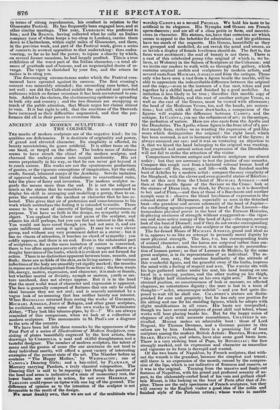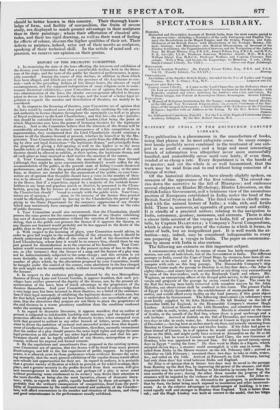ANCIENT AND MODERN SCULPTURE—A VISIT TO • THE COLISEUM.
THE merits of modern sculpture are of the negative kind ; for its qualities are deficiencies. It is destitute of originality and power, of, grand and elevated character. Its simplicity is affected, its beauty meretricious, its grace artificial. It is either tame on the one hand, or turgid on the other. The leaden mace of dulness seems to have struck the chisel of the modern sculptor, and charmed the embryo statue into insipid mediocrity. His art seems perpetually in his way, so that he can never get beyond it to Teach nature. His works are not the spontaneous productions of genius, or the vigorous conceptions of imagination, but the Cold, crude, formal, laboured essays of the Academy. Servile imitation of approved models, and literal obedience to conventional rules, take the place of fancy and invention. The modern sculptor re- gards the' means more than the end. It is not the subject so much as the statue that he considers. He is more concerned to display his skill in arranging and modelling a group, than to ex- press the sentiment of the incident or character that he has se- lected. This gives that air of pretension and consciousness to his work which neutralizes the feeling it is intended to excite. There seems to be a want of sincerity of feeling and of earnestness of purpose. You have no faith in the design, no sympathy with its object. You applaud the labour and pains of the sculptor, and admire his skill perhaps, but you can feel no interest in the work. You would not have cared though you had not seen it, and are quite indifferent about seeing it again. It may be a very clever group, and without any very prominent defect as a statue ; but it has no charm of attraction, it touches no chord of sympathy : you coldly approve, and there is an end. Even in the substantial part of sculpture, as far as the mere imitation of nature is concerned, there is too often apparent a poverty of style; meagre stiffness or a doughy heaviness of the limbs, which it is evident are not formed for action. There is no distinction apparent between bone, muscle, and flesh; there are no folds. of the skin, as in living nature; the various inflections of the body are smoothly yet rigidly marked; the muscles in repose are not distinguished from those in action ; the form wants life, energy, motive, expression, and character; it is male or female, but whether mortal or divinity, nymph or matron, youth or ma- ture manhood, does not always appear. But. it is in the head that the most woful want. of character and expression is apparent. The face is generally composed of features that can only be called ideal because they are not real; and is scarcely animated by a vague look of no-meaning that has neither beauty nor interest. When ROUBILIAC returned from seeing the works of GHIBERTI, MICHAEL ANGELO, JOHN of Bologna, and other great sculptors, he exclaimed, on seeing some of his own works in Westminster Abbey, "They look like tobacco-pipes, by G--!.. We are always reminded of this comparison, when we look at a collection of modern sculpture. The monuments in St. Paul's are a disgrace to the arts of the country. We have been led into these remarks by the appearance of the First Part of a series of Illustrations of Modern Sculpture, con- sisting of plates beautifully engraved by the best artists, from drawings by CORBOULD, a neat and skilful draughtsman and a tasteful designer. The number of modern sculptors, the talent of many and the genius of some (for our strictures do not tend to deny individual merit), will afford a great variety of interesting examples of the present state of the art. The Number before us contains " The Happy Mother," by WEsrmAeorr ; one of CANOVA'S Dancing Girls; and a bas-relief, by FLAXMAN, of Mercury carrying Pandora, a truly classical composition. The Dancing Girl is said to be reposing; but though the position of -the head and arms is indicative of a state of momentary rest, the lover limbs. are surely in action, for not even HEBERLE or TAGLIONI could repose on tiptoe with one leg off the grolind." The difference of opinion as to the intention of the sculptor is not favourable to the merit of the design. We must frankly own, that we are not of the multitude who worship CANOVA as a second PHIDIAS. We hold his taste to be . artifieial in its elegance. His Nymphs and Graces are French operasdancers; and are all of a class petite in form, and meretri- cious in character. His statues, too,have that conscious air Which seems to appeal to the beholder for admiration ; and his goddesses have too much of the coquette. His Graces, beautifully as they are grouped and modelled, do not ravish the mind and senses, as so lavish a display of female loveliness should do. The fact is, the faces want sentiment ; the soul of beauty is not there. There is a cast of this celebrated group (the original of which is, we be- lieve, at Woburn) in the Saloon of Sculpture at the Coliseum; and we invite our readers to walk with us through the gallery, which contains original models and sculptures by modern artists, and several casts from MICHAEL ANGELO and from the antique. Those only who have seen a cast from a figure beside the marble, will be able to appreciate the indescribable difference between the original and the copy,—even in the instance of' a fine cast, taken and put together by a skilful hand, and finished by a good modeller. An imitation is less likely to be true ; therefore this marble copy of the Venus de Medicis, and this cast of another antique Venus, as well as the cast of the Graces, must be viewed with allowance ; the head of the Medicean Venus, too, and the hands, are restora- tions; but still, with all these drawbacks, a comparison of the figures will explain the difference between CANOVA and the antique. In CANOVA, you see the refinement of art; in the antique, the perfection of nature. Here are also casts from the Apollo and the Discobolus. The Apollo, whose figure is the beau ideal of a per- fect manly form, strikes us as wanting the expression of god-like scorn which distinguishes the original : the right hand, which has been restored, is not in harmony with the rest of the figure; it always annoyed our eye; and it was on venturing an objection to it, that we heard the hand belonging to the original was wanting. The graceful and natural action and expression of the Discobolus will not fail to strike the attention of the visitor.
Comparisons between antique and modern sculpture are almost unfair; but they are necessary to test the justice of our remarks. Compare this rough cast from a battered colossal bronze head of Alexander—all fire, energy, and life—with the finished marble bust of Achilles by a modern artist : compare the easy simplicity of the Shepherd, with the clever and even graceful statue of Bifcehus : look at this cast from the Christ of MICHAEL ANGELO :—and then at the marble figure of the Saviour on the Cross : look at the statues of Diana (not, we think, by PHIDIAS, as it is described to be) and of Flora,—and then at those of a Bacchante and another nymph near it : observe the bland loveliness of expression in the colossal statue of Melpomene, especially as seen in the detached bust—the grandeur and severe solemnity of the head of Jupiter— the conflicting agonies expressed in the head of the Laocoon—the tremendous physical power in the bust of the Farnese Hercules, displaying an excess of strength without exaggeration—the vigor- ous and more active energy of the head of Ajax—the eager, earnest look of the bust of Diomed ; and if they do not awake corresponding emotions in the mind, either the sculptor or the spectator is wrorig.
The far-famed Moses of MICHAEL ANGELO, grand and ideal as it is, appears to us like an attempt to personify moral dignity by mere physical strength. The face, too, has corresponding traits of animal character; and the horns are satyrical rather than em- blematical. As a statue, however, it is sublime in its personifica- tion of human power; as that of Lorenzo de Medicis, by the same great sculptor, is in its representation of an individual. The re- pose and ease, nay, the careless familiarity of the attitude of this wonderful figure, and the graceful sway of the limbs, impress the mind with a feeling of respect and awe. The warrior sits with his legs gathered rather under his seat, his head leaning on one hand in a musing posture, and the other resting on his thigh, "like Might half slumbering on his own right arm." Here is no strained position, no consciousness of look or manner, no affected elegance, no ostentatious dignity ; the man is lost in a train of thought—" sedet, mternumque sedebit "—and you feel quite dis- posed to wait till he shall rise. CHANTREY'S statues are distin- guished for ease and propriety; but he has only one position for his sitting and one for his standing figures, which he adopts with slight modifications in all cases. His busts are unequalled; though we have several sculptors of great skill and talent, whose works will bear placing beside his. But for the happy union of elegance of style with accurate resemblance, CHANTREY is un- rivalled. MOORE makes an admirable bust : those of Lord Nugent, Sir Thomas Denman, and a German painter in this saloon are by him. Indeed, there is a promising list of bust sculptors among the modern British Artists: BEHNES, BURLOWE, SHARP, HENNING, and others, have also some good busts here. There is a very striking bust of Pope, by ROUBILIAC; the face strongly marked, and its expression and character as masculine and vigorous as its form is decrepid and wasted. Of the two busts of Napoleon, by French sculptors, that with- out the wreath is the grandest, because the simplest and truest; still there is an expression of the mouth, caused by the compres- sion of the lips, which is not indicative of firmness and reserve, as it was in the original. Turning from the massive and finely-cut features of Napoleon, with his grand and profound serenity of as- pect, to the elaborately-curled head of his vain and gallant chief- tain Murat, is like looking on the bust of Paris after that of Ju- piter. These are the only specimens of French sculpture, but they will convey to the English visitor a good idea of the noble and finished style of the Parisian artists; whose works in marble should be better known in this country. Their thorough know- ledge of form, and facility of composition, the fruits of severe study, are_displayed to much greater advantage in their sculpture than in their paintings ; where their affectation of classical atti- tudes, and their too rigid drawing, as well as their want of feeling for effects of colour, obscure the higher qualities of their art. Their defects as painters, indeed, arise out of their merits as sculptors, speaking of their technical skill. In the article of mind and ex- pression, we reserve our opinion on their genius.



























 Previous page
Previous page